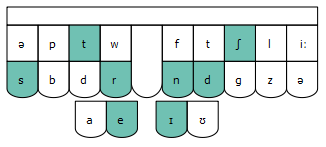-
Notifications
You must be signed in to change notification settings - Fork 2
Lesson 2: Keys
Gregory Chamberlain edited this page Oct 14, 2018
·
2 revisions
The Phenrsteno layout is built to transcribe phonemes, so printed on the keys are the IPA symbols that represent those phonemes. Below is a simplified diagram of the layout.

Look at this Wikipedia article to see what phonemes these symbols correspond to.
To transcribe a word, first split it into syllables, then for each syllable think about:
- How the syllable is pronounced
- The sequence of phonemes that describe its pronunciation
- The steno stroke for each phoneme
Step (1) you already know. Then there are some resources to help you with step (2) if you get stuck:
- Look it up in this chart on Wikipedia
- Look up your word on Wiktionary and see if it has an IPA transcription
For step (3) you should memorise the information in the diagrams and tables in this article.
-
"Trash" is pronounced /traʃ/, so its stroke is
traʃ

-
"Send" is pronounced /sεnd/, so its stroke is
send(theekey is used for the /ε/ phoneme).

-
"Tetris" has two syllables: /tε trɪs/, so its strokes are
te/trɪf(-fis also used for the /v/ and /s/ phonemes).

-
"Race" (/reɪs/) and "raise" (/reɪz/) are distinguished only by their last phoneme. Their strokes are
reɪfandreɪz, respectively.


-
"Strange" is pronounced /streɪndʒ/, so its stroke is
streɪndʃ(since-ʃis also used for /ʒ/).

- For a word like "bidding" we can use
-gto append the '-ing' suffix:bɪdfor 'bid', butbɪdgfor 'bidding' (otherwise it would be two syllables:bɪ/dɪngfor /bɪ dɪŋ/).


-
"Piled" is pronounced /paɪld/, so its stroke is
paɪdl(the-dkey acts as the{^ed}suffix in this case, despite occuring before-l).
